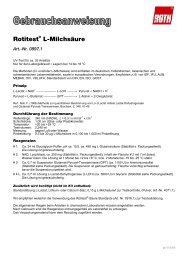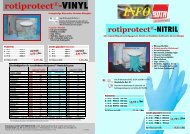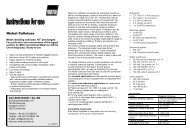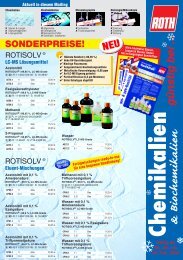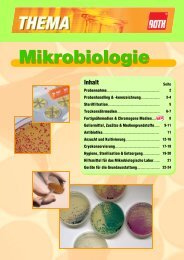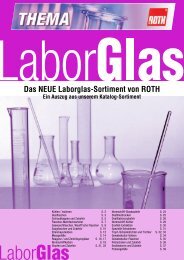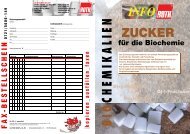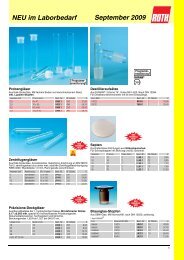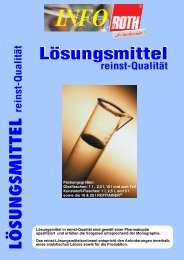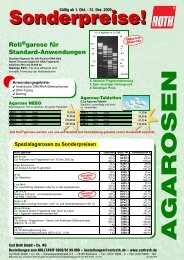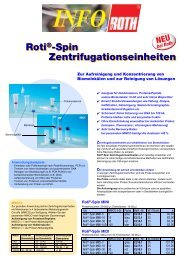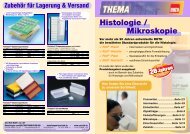Rotiphorese Proclamp MINI Tank Blotting System - Carl Roth
Rotiphorese Proclamp MINI Tank Blotting System - Carl Roth
Rotiphorese Proclamp MINI Tank Blotting System - Carl Roth
Create successful ePaper yourself
Turn your PDF publications into a flip-book with our unique Google optimized e-Paper software.
<strong>Rotiphorese</strong> ® PROclamp <strong>MINI</strong><br />
<strong>Tank</strong> <strong>Blotting</strong> <strong>System</strong><br />
3513.1 <strong>Rotiphorese</strong> ® PROclamp <strong>MINI</strong><br />
<strong>Tank</strong> <strong>Blotting</strong> <strong>System</strong><br />
⇒ <strong>Tank</strong> + <strong>Blotting</strong> module incl. accessories<br />
3517.1 <strong>Rotiphorese</strong> ® PROclamp <strong>MINI</strong><br />
<strong>Tank</strong> <strong>Blotting</strong> Module<br />
⇒ <strong>Blotting</strong> module incl. accessories<br />
WARNING:<br />
Please read the entire operator’s manual thoroughly before operating this unit.<br />
Warning:<br />
Like all apparatus run by electricity these units are capable of delivering potentially lethal voltage<br />
when connected to a power supply. They should be operated only by qualified technically trained<br />
personnel.<br />
The tank blotting units from ROTH are designed for long term laboratory use and to obtain<br />
reproducible results. Please spend a few moments reading the instruction manual thoroughly.<br />
These units comply with the statutory CE safety rules:<br />
73/23/EEC: Low voltage directive: IEC 1010-1:1990 plus amendment 1:1992<br />
EN 61010-1:1993/BS EN 61010-1:1993<br />
Please verify that you received the unit completely and without any damage. Any faults or losses<br />
have to be reported to ROTH immediately. ROTH can not accept responsibility for goods that were<br />
sent back without informing them.<br />
Please take a look at the packing list and check whether all components and accessories are<br />
present.<br />
Please retain all packaging material until the warranty period has expired.<br />
For further information, please contact us at Tel.: 0721/5606-0.<br />
1
SPECIFICATIONS<br />
Technical features:<br />
� User-friendly injection molded construction, 100 % leak-proof<br />
� Doubly insulated cables, rated safe up to 1000 volts<br />
� Gold plated electrical connectors, corrosion-free and rated safe up to 1000 volts<br />
� Recessed power connectors, integral with the safety lid<br />
� 0.2 mm diameter platinum electrodes, 99,99 % pure<br />
� User replacable platinum electrodes<br />
Overall dimensions (W x L x H) 13 x 20 x 13.5 cm<br />
Approx. total buffer volume 1.5 Liter<br />
Electrode separation distance 6 cm<br />
No. of gel cassette slots 4<br />
Max. gel size 10 x 10 cm<br />
Max. operating voltage 200 V<br />
Max. operating current 1000 mA<br />
Electrical connectors 4 mm male, fully shrouded<br />
Environmental Conditions<br />
� This apparatus is intended for indoor use only.<br />
� The unit can be operated safely at an altitude of 2000 m.<br />
� The normal operating temperature range is between 4 °C and 65 °C.<br />
� Maximum relative humidity 80 % for temperatures up to 31°C decreasing linearly to<br />
50 % relative humidity at 40 °C.<br />
All <strong>Roth</strong> products available for delivery have undergone rigorous quality controls.<br />
PACKING LIST<br />
Content 3513.1 (system) 3517.1 (module)<br />
<strong>Tank</strong> with lid and cables 1 -<br />
<strong>Blotting</strong> module 1 1<br />
<strong>Blotting</strong> cassettes 4 4<br />
<strong>Blotting</strong> mats 8 8<br />
AVAILABLE ACCESSORIES<br />
(All accessories can be purchased from <strong>Carl</strong> <strong>Roth</strong> GmbH + Co. KG. Please use the indicated ordering numbers.<br />
Additional reagents and accessories can be found in top I.)<br />
<strong>Tank</strong> (without lid) 3509.1<br />
Replacement lid for tank 3511.1<br />
<strong>Blotting</strong> cassettes piece 3518.1<br />
<strong>Blotting</strong> mats pair 3519.1<br />
2
USING THE VERTICAL GEL ELECTROPHORESIS UNITS<br />
A. Safety Precautions<br />
Please read the entire instruction manual thoroughly before using the apparatus.<br />
Always isolate electrophoresis units from their power supply before removing the safety cover. Isolate<br />
the power supply from the mains first then disconnect the leads.<br />
Do not exceed the maximum operating voltage or current (see table 1).<br />
Acrylamide is a volatile, concentrated neurotoxin which is suspected to be carcinogenic. Please<br />
always wear protective clothing when working with acrylamide and follow and observe the working<br />
instructions / directions for disposal carefully. Polymerized gels contain residue of unpolymerized<br />
monomer. Please wear always protective gloves while working.<br />
Do not fill the unit with running buffer above the maximum fill lines.<br />
Do not move the unit when it is running.<br />
Caution:<br />
During electrophoresis very low quantities of various gases are produced at the electrodes. The type<br />
of gas produced depends on the composition of the buffer employed. To disperse these gases make<br />
sure that the apparatus is run in a well ventilated area.<br />
B. General Care and Maintenance<br />
Clean the apparatus with hand warm water and a mild detergent only. Often, a thorough rinse with<br />
distilled water is all that is required. Dry components with clean tissues prior to use, e.g. ROTH tissues<br />
(ref. 0087.1)<br />
Important: Acrylic plastic is not resistant to aromatic or halogenated hydrocarbons, ketones, esters,<br />
alcohols (over 25 %) and acids (over 25 %), they will cause „crazing“of the plastic and should not be<br />
used for cleaning. Do not use abrasive creams or scourers. The units should never come into contact<br />
with the following cleaning agents, these will cause irreversible and accumulative damage: Acetone,<br />
Phenol, Chloroform, Carbon tetrachloride, Methanol, Ethanol, Isopropyl alcohol, Alkalis.<br />
Before use, and then on a monthly basis, check the unit for any leaks at the bonded joints. Place the<br />
unit on a sheet of dry tissue and then fill with distilled water only to the maximum fill line. If any<br />
leakage is seen do not attempt to repair or use the apparatus, but notify <strong>Carl</strong> <strong>Roth</strong> GmbH & Co. KG<br />
immediately (+49/0721/5606-172).<br />
The replacement platinum electrodes are partially shrouded for protection. However, when cleaning<br />
the main tank do not use cleaning brushes in the electrode area.<br />
Ensure that the connectors are clean and dry before usage or storage.<br />
C. RNase Decontamination<br />
Clean the units with a mild detergent as described above.<br />
Wash with 3% hydrogen peroxide (H O ) for 10 minutes.<br />
2 2<br />
Rinsed with 0.1% DEPC- (diethyl pyrocarbonate) treated distilled water,<br />
Caution: DEPC is a suspected carcinogen. Always take the necessary precautions when using.<br />
Roti ® -Nucleic Acid free (Art. No. HP69) and RNAse AWAY (TM)<br />
(Art. No. A998) may also be used.<br />
Please consult the instructions for use with acrylic gel tanks.<br />
D. Fitting Electrode Cables.<br />
1. Note the position of the lid on the unit. This shows the correct polarity and the correct orientation<br />
of the cables, black is negative and red positive.<br />
2. Remove the lid from the unit. Note if the lid is not removed, fitting the cables may result in untightening<br />
of the gold plug and damage to the electrode.<br />
3. Screw the cables into the tapped holes as fully as possible so that there is no gap between the lid<br />
and the leading edge of the cable fitting.<br />
4. Refit the lid.<br />
3
E. Preparations<br />
Cool the appropriate volume of transfer buffer. The PROclamp <strong>MINI</strong> <strong>Tank</strong>-Blot units will require<br />
approximately 1.2 Litres of transfer buffer, dependend on the number of cassettes inserted (see<br />
table). If required, the buffer should be degassed prior to the addition of SDS.<br />
No. of Cassettes<br />
1 2 3 4<br />
Buffer volume in ml 1380 1290 1200 1110<br />
The most commonly used transfer buffer is<br />
• 25 mM Tris, 192 mM glycine, 20 % methanol, pH 8.3, Ref. Towbin et al (1979).<br />
This buffer can be used with or without 0.05-0.1 % (w/v) SDS.<br />
Other transfer buffers are:<br />
• 48 mM Tris, 39 mM glycine, 20 % methanol, pH 9.2, Ref. Bjerrum and<br />
Schafer-Nielsen (1986)<br />
• 10 mM NaHCO 3 , 3 mM NaCO 3 , 20 % methanol, pH 9.9, Ref. Dunn (1986).<br />
Note: Transfer parameters depend on the buffer system used! See following table.<br />
Transfer Buffer Overnight 1 hour 3 hours<br />
Tobwin Buffer 25-40 V 50-100 V 25-50 V<br />
40-80 mA 200-400 mA 100-200 mA<br />
Bjerrum Buffer 25-40 V 50-100 V 25 – 50 V<br />
40-80 mA 200-400 mA 100 – 200 mA<br />
Dunn Buffer 10 V 40-80 V 20 – 40 V<br />
40-80 mA 200-500 mA 100 – 250 mA<br />
1. Half fill the tank with transfer buffer.<br />
2. Pre-equilibrate the gel for 30 minutes in cool transfer buffer to remove SDS and salts. This serves<br />
to prevent the gel changing size during transfer and to reduce heating effects.<br />
3. Soak a gel-sized piece of transfer membrane in transfer buffer for 15 minutes.<br />
4. Cut two pieces of blotting paper (A125.1) and a piece of transfermembrane (Roti ® -PVDF T830.1,<br />
Roti ® -Fluoro-PVDF 2803.1, Roti ® -NC HP40.1) to the size of the gel to be blotted.<br />
5. If you are using PVDF-membrane, incubate the membrane in 100% methanol until it is completely<br />
soaked. Nitrocellulose should be equilibrated in transfer buffer.<br />
6. Soak the fibre pads and the blotting papers in transfer buffer.<br />
F. Assembly of blot sandwiches<br />
Assemble the gel/membrane sandwich in the compression cassette as described and shown (fig. 1).<br />
Be careful to avoid air bubbles, which can be done as follows:<br />
Either use a tray filled with transfer buffer. Assembly is performed entirely under buffer.<br />
Or assemble the transfer unit on top of a flat tray. After positioning of each layer, use a clean glass rod<br />
or pipette wet in transfer buffer to roll out any trapped bubbles.<br />
Note: Try to avoid repositioning the membrane as some transfer may occur on first contact.<br />
Assemble in the order:<br />
1. Black cassette clamp (-ve side)<br />
2. Pre-soaked fibre pad<br />
3. Some sheets of pre-soaked blotting paper (approx. 2 mm thick overall)<br />
4
4. Gel<br />
5. Pre-wetted transfer membrane<br />
6. Some sheets of pre-soaked blotting paper (approx. 2 mm thick overall)<br />
7. Pre-soaked fibre pad<br />
8. Red cassette clamp (+ve side)<br />
For very thin gels use 2 mats on each side.<br />
Close the hinge carefully so as to not disturb the sandwich.<br />
Cathode (black) (-ve) Anode (red) (+ve)<br />
<strong>Blotting</strong> Paper<br />
Compression<br />
Cassette<br />
Fibre<br />
Pads<br />
Gel<br />
Transfer<br />
Membrane<br />
<strong>Blotting</strong> Paper<br />
Compression<br />
Cassette<br />
G. <strong>Blotting</strong><br />
1. Insert the cassettes into the <strong>Blotting</strong> module.<br />
2. Optional: It is a good idea to note the orientation and order the blot sandwiches were loaded in.<br />
3. Use of a magnetic stirring bar and plate is recommended to mix the buffer to give consistency of<br />
transfer. A 4mm diameter stirring bar should be placed in the centre of the tank.<br />
4. Insert the <strong>Blotting</strong> module into the tank with the transfer membrane on the +ve side. Note: The +ve<br />
(red) side of each cassette should be placed nearest to the +ve side of the module.<br />
5. Add further transfer buffer up to the maximum fill line indicated on each side of the tank. Now the<br />
top loops of the platinum coils should be just covered. Do not fill beyond the maximum fill lines.<br />
6. Apply the safety lid and turn the magnetic stirrer on, in order to keep the buffer in weak agitation.<br />
7. Connect to a power supply. Refer to Table 1 for run conditions. Note that operating conditions<br />
should be optimised for your applications.<br />
Factors that will affect the success of transfer include: gel porosity, buffer composition and pH,<br />
transfer time, transfer field density (V/cm), molecular weight range, temperature of buffer, choice<br />
5
of membrane and the detection system chosen. Residual salts in the gel could cause the system<br />
to heat up so pre-equilibration of the gel with transfer buffer is important.<br />
8. Monitor the temperature as the run proceeds. Improved transfer can usually be obtained by using<br />
chilled buffer. Additionally, frozen Cooling Pads (3512.1, accessories of the <strong>Rotiphorese</strong> ®<br />
PROclamp Vertical Electrophoresis Units) may be inserted on each side of the tank to cool the<br />
buffer during the blot.<br />
9. When the blot time is completed, turn the power supply off.<br />
10. Remove the cassettes from the main tank.<br />
11. Lift the hinge of each cassette and gently pry apart the blot sandwich and remove the membrane<br />
from the gel. Restain the gel in order to check the blot efficiency.<br />
12. The membrane is now ready to be probed.<br />
H. References:<br />
1. Molecular Cloning A Laboratory Manual, Sambrook, Fritsch, and Maniatis, Second Edition,<br />
Cold Spring Harbor Laboratory Press, 1989.<br />
2. Current Protocols in Molecular Biology, Greene Publishing Associates and Wiley-<br />
Interscience,1989.<br />
3. Electrophoretic transfer of proteins from polyacrylamide gels to nitrocellulose sheets:<br />
Procedure and some applications, Towbin, J., Staehelin, T., and Gordon, J. (1979). Proc. Natl.,<br />
Acad. Sci. USA, 76, 4350-4354.<br />
4. <strong>Blotting</strong> Techniques Ch.1, 7.10, p. 85-97. In: Gel Electrophoresis of Proteins,<br />
A Practical Approach, B.D.Hames and D.Rickwood, eds., IRL Press. (1990),<br />
I. Further reagents<br />
All chemicals and accessories required and be found in our main catalogue or on the internet at<br />
www/carlroth.com<br />
Rotilabo ® <strong>Blotting</strong>papers 0.36 mm CL67.1<br />
Rotilabo ® <strong>Blotting</strong>papers 1 mm CL74.1<br />
Rotilabo ® <strong>Blotting</strong>papers 1.5 mm CL75.1<br />
Roti ® -Fluoro PVDF Membrane (roll) 2803.1<br />
Roti ® -PVDF Membrane (roll) T830.1<br />
Roti ® -NC Membrane (roll) HP40.1<br />
Giemsa-protein staining solution Roti ® -Blue A152<br />
Roti ®<br />
-Green fluorescent staining solution 1000<br />
<strong>Rotiphorese</strong> PROclamp <strong>MINI</strong> <strong>Tank</strong>-Blot-<strong>System</strong> 3513.1<br />
<strong>Rotiphorese</strong> PROclamp <strong>MINI</strong> <strong>Tank</strong>-Blot-Module 3517.1<br />
<strong>Carl</strong> <strong>Roth</strong> GmbH + Co. KG<br />
Schoemperlenstraße 3-5<br />
76185 Karlsruhe<br />
Postfach 100121<br />
76231 Karlsruhe<br />
Telefon: +49 (0) 721/ 5606-0<br />
Telefax: +49 (0) 721/ 5606-149<br />
E-mail: info@carlroth.de<br />
Internet: www.carlroth.de<br />
s.s. 09/2009<br />
6



